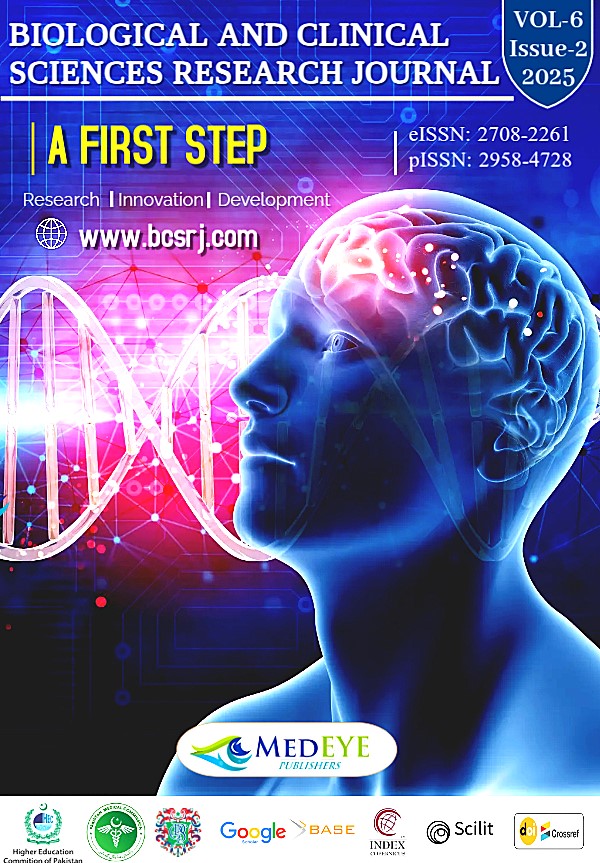Navigating the Challenges of Ureteral Stones: A Comparative Analysis of Outcomes for Impacted and Non-Impacted Stones Treated with Semi-Rigid Ureteroscop
DOI:
https://doi.org/10.54112/bcsrj.v6i2.1593Keywords:
Ureteral stones, Semi-rigid ureteroscopy, Stone impaction, Operative outcomes, PakistanAbstract
Impacted ureteral stones pose significant clinical challenges and are associated with higher complication rates and increased operative difficulty. In developing countries like Pakistan, delayed diagnosis often leads to stone impaction. This study aimed to compare the intraoperative and postoperative outcomes of impacted versus non-impacted ureteral stones managed with semi-rigid ureteroscopy in a tertiary care setting. Methods: A prospective comparative study was conducted at the Institute of Kidney Diseases, Peshawar, from April to September 2024. Seventy-six patients with solitary ureteral stones were enrolled and classified intraoperatively into impacted and non-impacted groups. All patients underwent semi-rigid ureteroscopy with pneumatic lithotripsy. Data collected included demographics, stone size, operative time, complications, hospital stay, and stone-free rates (SFR). Statistical analysis was performed using SPSS v26, with p-values of less than 0.05 considered statistically significant. Results: The impacted group had significantly larger stones (mean size, 10.2 mm vs. 8.5 mm; p < 0.01) and longer symptom durations (7.8 vs. 3.1 weeks; p < 0.001). Operative time was longer (42.5 vs. 30.7 minutes; p<0.001), and ureteral dilation was more frequently required (71.1% vs. 23.7%; p<0.001) in the impacted group. Intraoperative bleeding (15.8% vs. 2.6%; p=0.04) and postoperative pain (52.6% vs. 26.3%; p=0.02) were significantly higher in impacted stones. A prolonged hospital stay (more than 24 hours) was observed in 47.4% of impacted cases, compared to 21.1% in non-impacted cases (p = 0.01). SFR was comparable between groups (89.5% vs. 97.4%; p = 0.18). Stone impaction and prolonged operative time were independent predictors of extended hospital stay. Conclusion: Impacted ureteral stones are associated with increased operative complexity, higher complication rates, and prolonged hospitalisation, despite similar stone clearance rates to non-impacted stones. Early detection and timely intervention are crucial for enhancing patient outcomes in resource-constrained settings.
Downloads
References
Hussain M, Lal M, Ali B, Parveen N. Prevalence and risk factors of urolithiasis in Pakistan: A cross-sectional study. Pak J Med Sci. 2021; 37(6):1571–6.
Bayar G, Dede O, Akbulut F, Karabulut E, Karaman MI. Association between ureteral stone impaction and operative outcomes of ureteroscopy: A prospective study. Urol Int. 2020; 104(1-2):62–7.
Bozkurt O, Penbegul N, Soylemez H, et al. Impacted Ureteral Stones: Evaluation of the Success Rate of Ureteroscopy and the Effect of Stone Impaction on Complications. Arch Ital Urol Androl. 2020; 92(4):237–41.
Shah SA, Siddiqui KM, Khalid S, Ali A. Semi-rigid ureteroscopy for ureteral calculi: Experience from a tertiary care center in Pakistan. J Pak Med Assoc. 2022; 72(3):550–4.
Qureshi AA, Tariq M, Khan MH, Abbas F. The role of ureteroscopy in the management of ureteric stones in a developing country. Pak J Surg. 2021; 37(1):15–9.
Farooq MA, Dar FS, Ghaffar A, Baloch S. Patterns and outcomes of ureteric stone disease in Pakistan: A tertiary hospital-based review. J Ayub Med Coll Abbottabad. 2020; 32(4):590–5.
Goel A, Hemal AK. Upper and Lower Ureteric Stones: Management with Semi-Rigid Ureteroscopy and Pneumatic Lithotripsy. J Endourol. 2021; 35(5):643–8.
Türk C, Petřík A, Sarica K, et al. EAU Guidelines on Interventional Treatment for Urolithiasis. Eur Urol. 2021; 80(2):131–42.
Ahmed S, Latif M, Rafique M. Delay in seeking treatment for urinary stones: A clinical audit from rural Punjab. Pak J Med Health Sci. 2023; 17(2):212–6.
Raza A, Ashfaq A, Qasim M, Jamil M. Self-medication and late diagnosis: Major contributors to ureteral stone impaction in Pakistani patients. Int J Urol Nurs. 2022; 16(1):20–5.
Bozkurt O, Penbegul N, Soylemez H, et al. Impacted Ureteral Stones: Evaluation of the Success Rate of Ureteroscopy and the Effect of Stone Impaction on Complications. Arch Ital Urol Androl. 2020; 92(4):237–41.
Bayar G, Dede O, Akbulut F, Karabulut E, Karaman MI. Association between ureteral stone impaction and operative outcomes of ureteroscopy: A prospective study. Urol Int. 2020; 104(1-2):62–7.
Goel A, Hemal AK. Upper and Lower Ureteric Stones: Management with Semi-Rigid Ureteroscopy and Pneumatic Lithotripsy. J Endourol. 2021; 35(5):643–8.
Kim BS, Lee JN. The Association between Stone Migration and Stone Impaction during Ureteroscopy: A Prospective Analysis. Urology. 2022; 165:72 8.
El-Nahas AR, Ibrahim HM, El-Assmy AM, et al. Postoperative Pain after Ureteroscopy: The Impact of Stone Impaction and Operative Time. Urol Ann. 2021; 13(3):238–42.
Singh V, Sinha RJ, Sankhwar SN. Prolonged Hospital Stay in Ureteroscopic Lithotripsy: Predictive Factors and Risk Assessment. Urol J. 2022; 19(5):411–7.
Shah SA, Siddiqui KM, Khalid S, Ali A. Semi-rigid ureteroscopy for ureteral calculi: Experience from a tertiary care center in Pakistan. J Pak Med Assoc. 2022; 72(3):550–4.
Türk C, Petřík A, Sarica K, et al. EAU Guidelines on Interventional Treatment for Urolithiasis. Eur Urol. 2021; 80(2):131–42.
Ahmed S, Latif M, Rafique M. Delay in seeking treatment for urinary stones: A clinical audit from rural Punjab. Pak J Med Health Sci. 2023; 17(2):212–6.
Downloads
Published
How to Cite
Issue
Section
License
Copyright (c) 2025 Maaz Khan, Zahid Majeed, Misbah Ur Rahman, Nadeem Sohail, Nasir Khan

This work is licensed under a Creative Commons Attribution-NonCommercial 4.0 International License.








